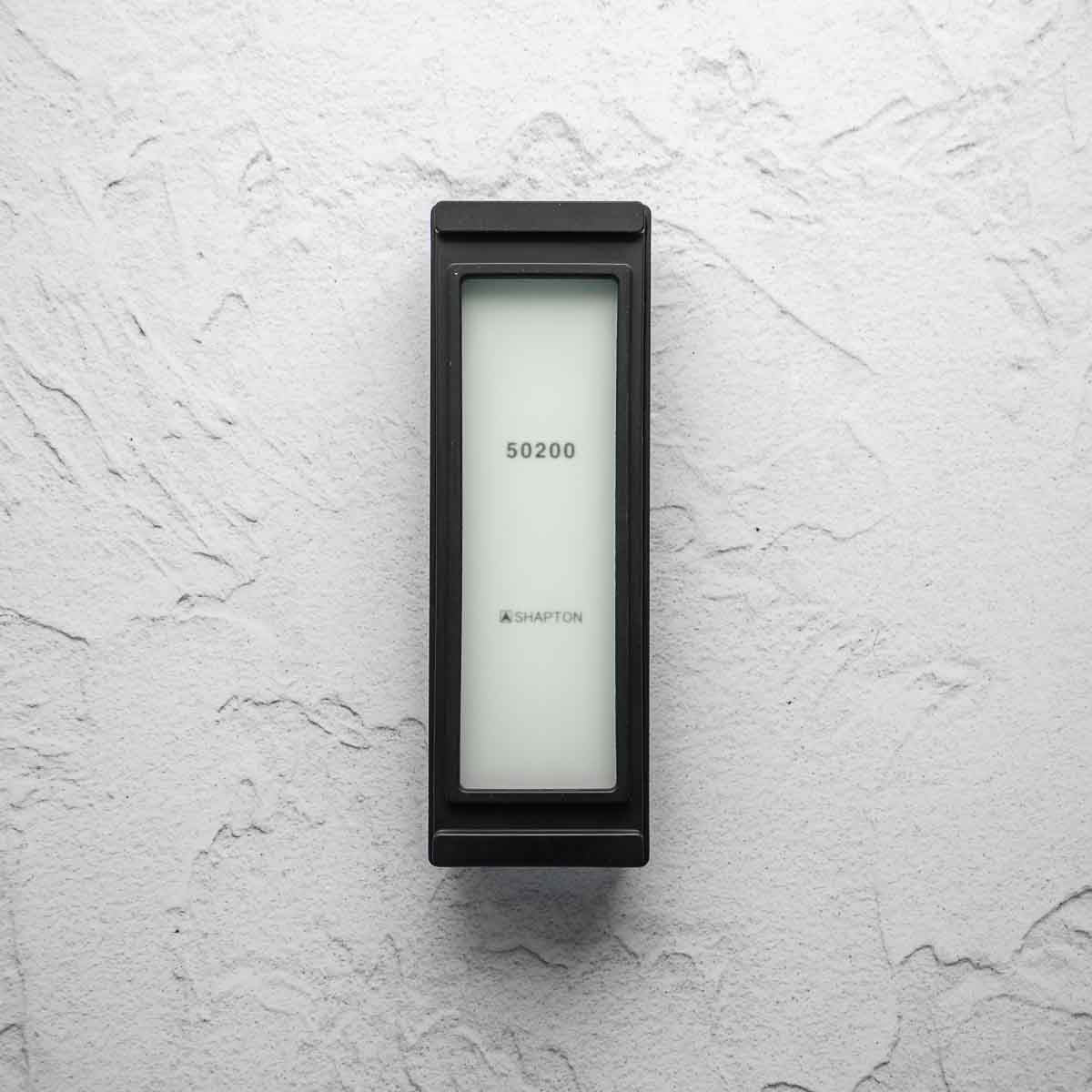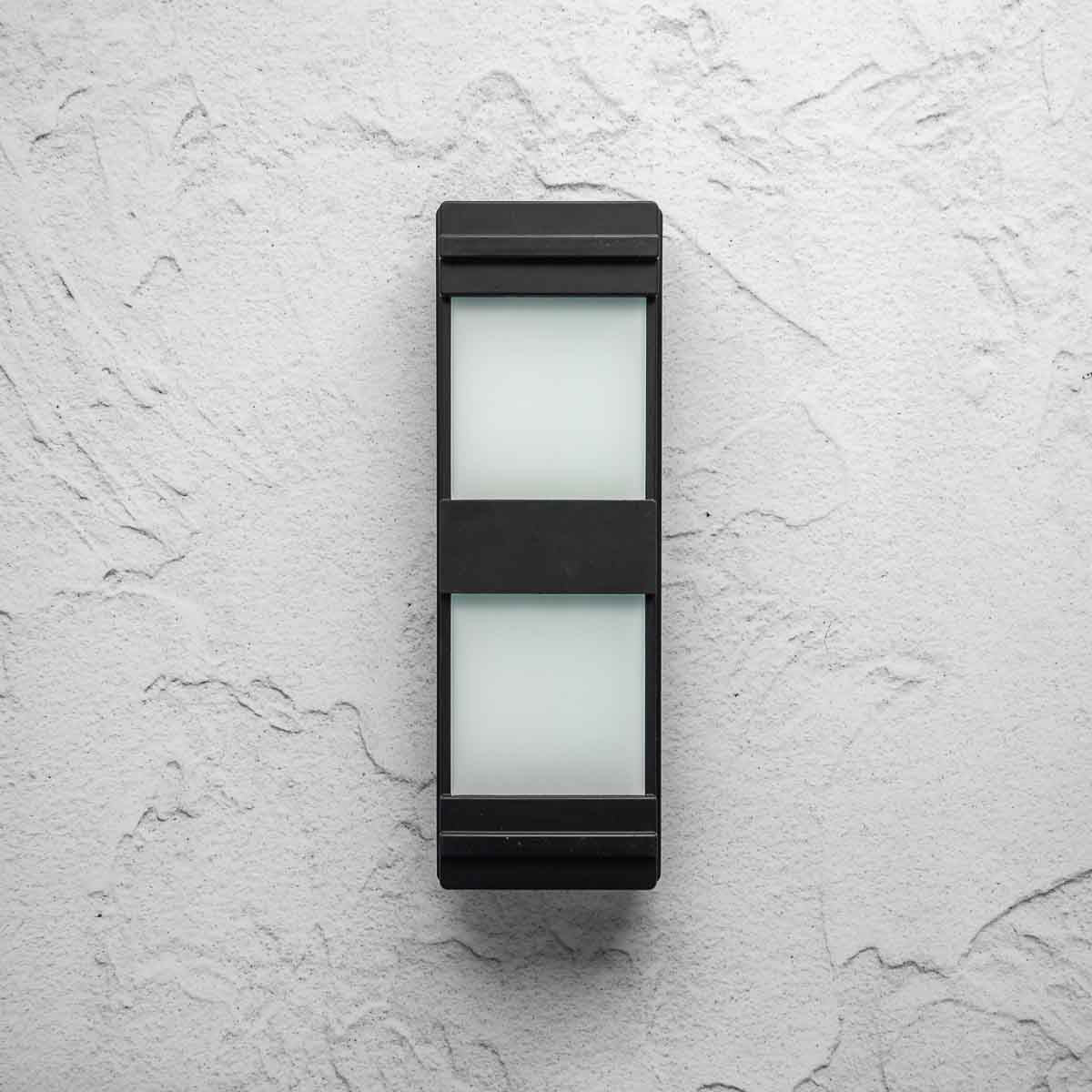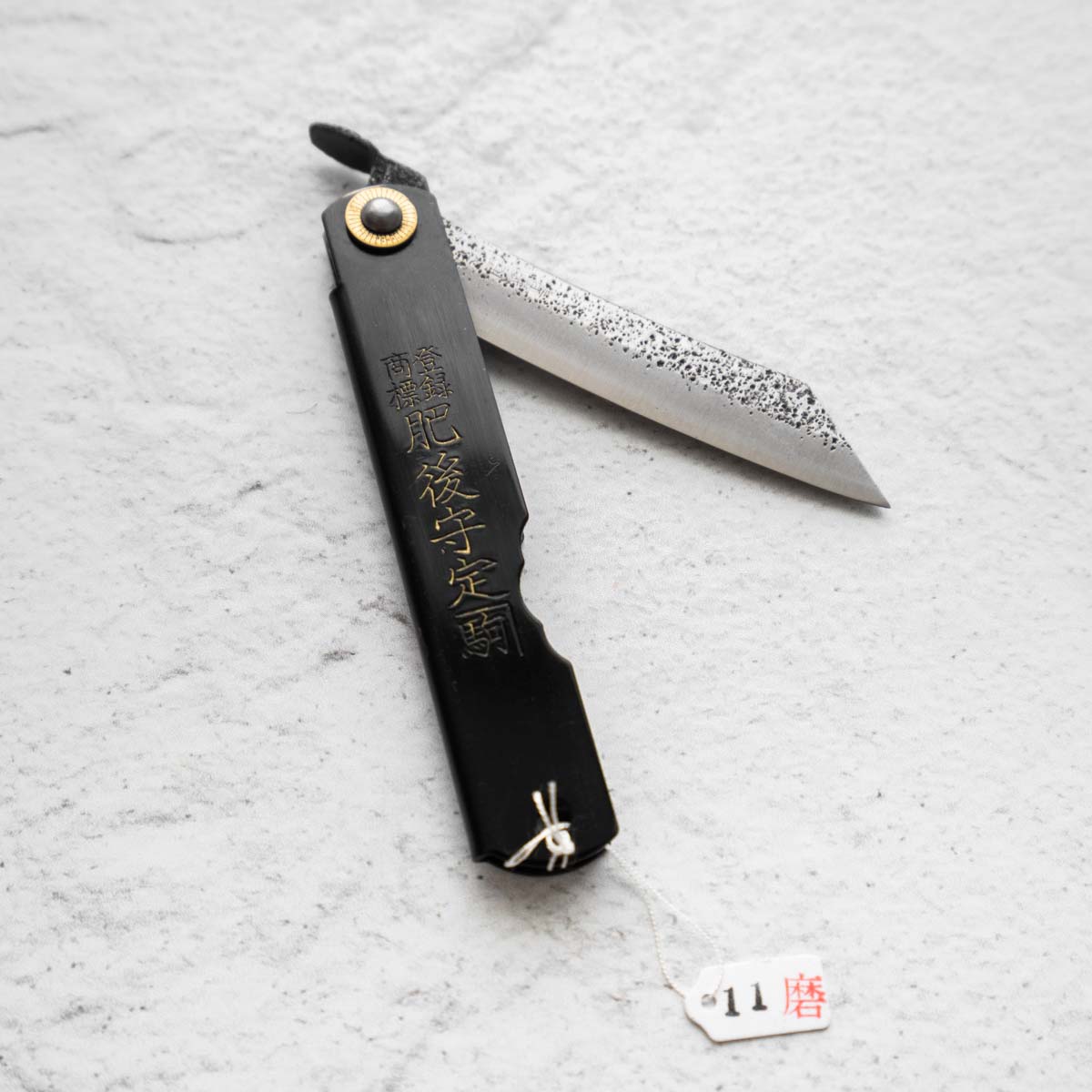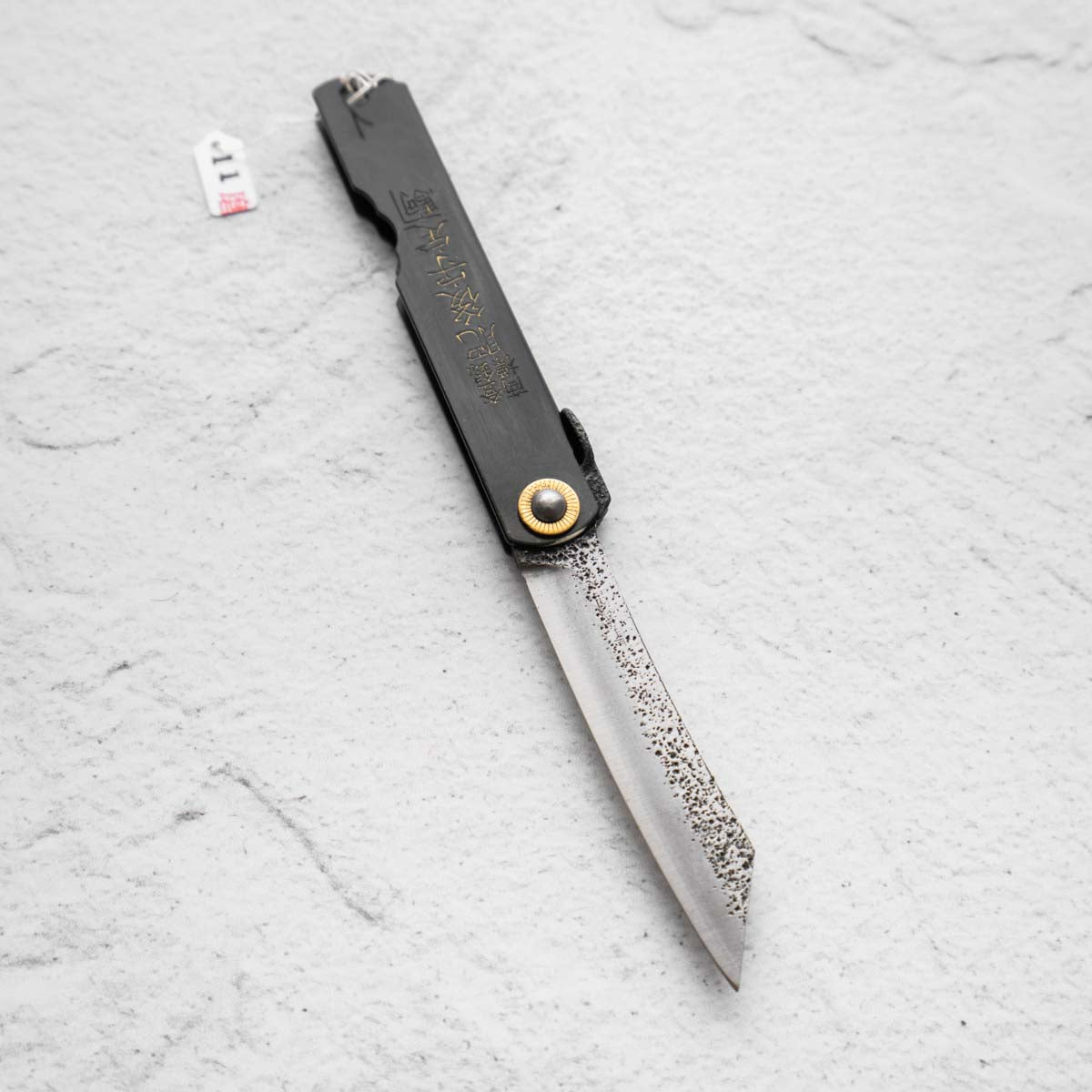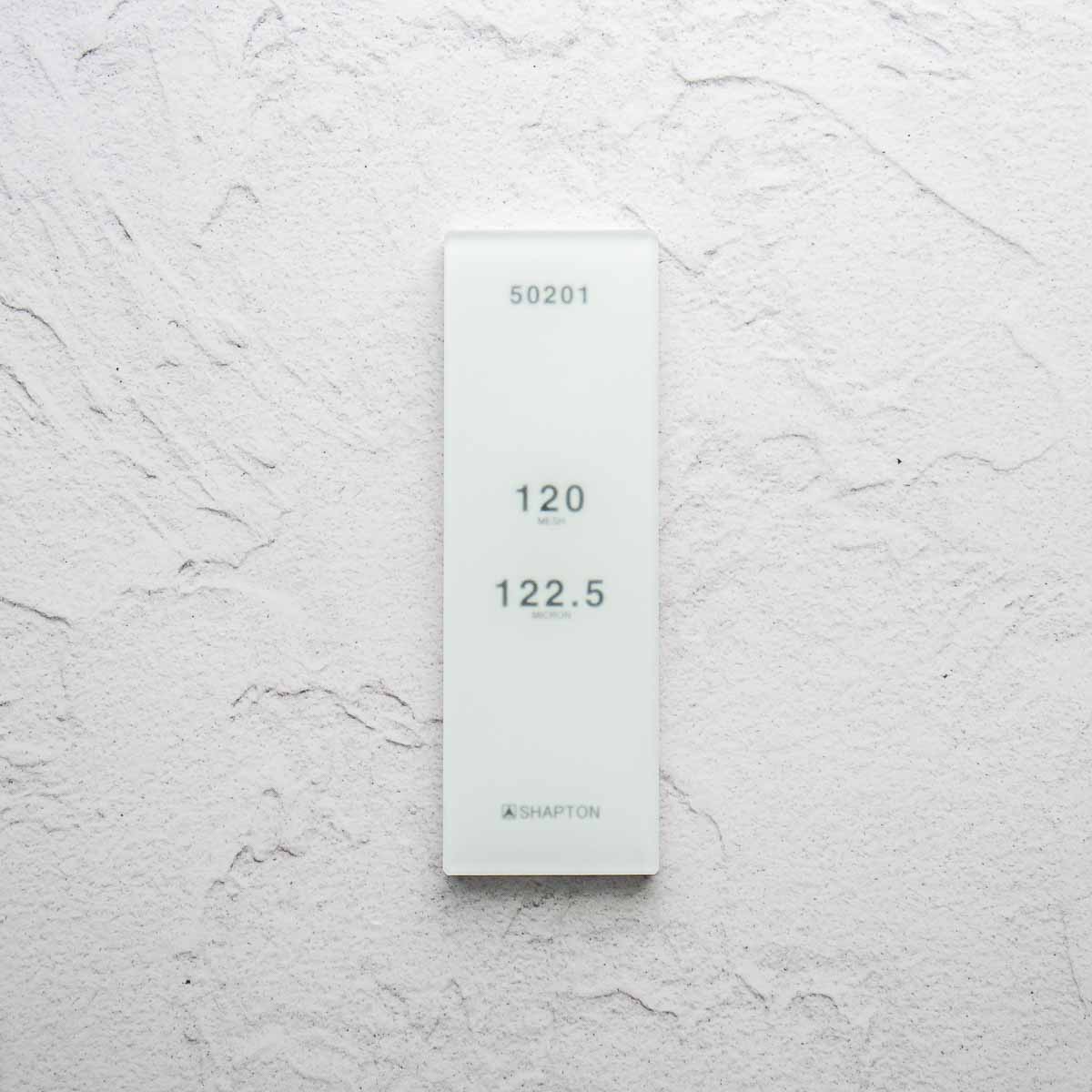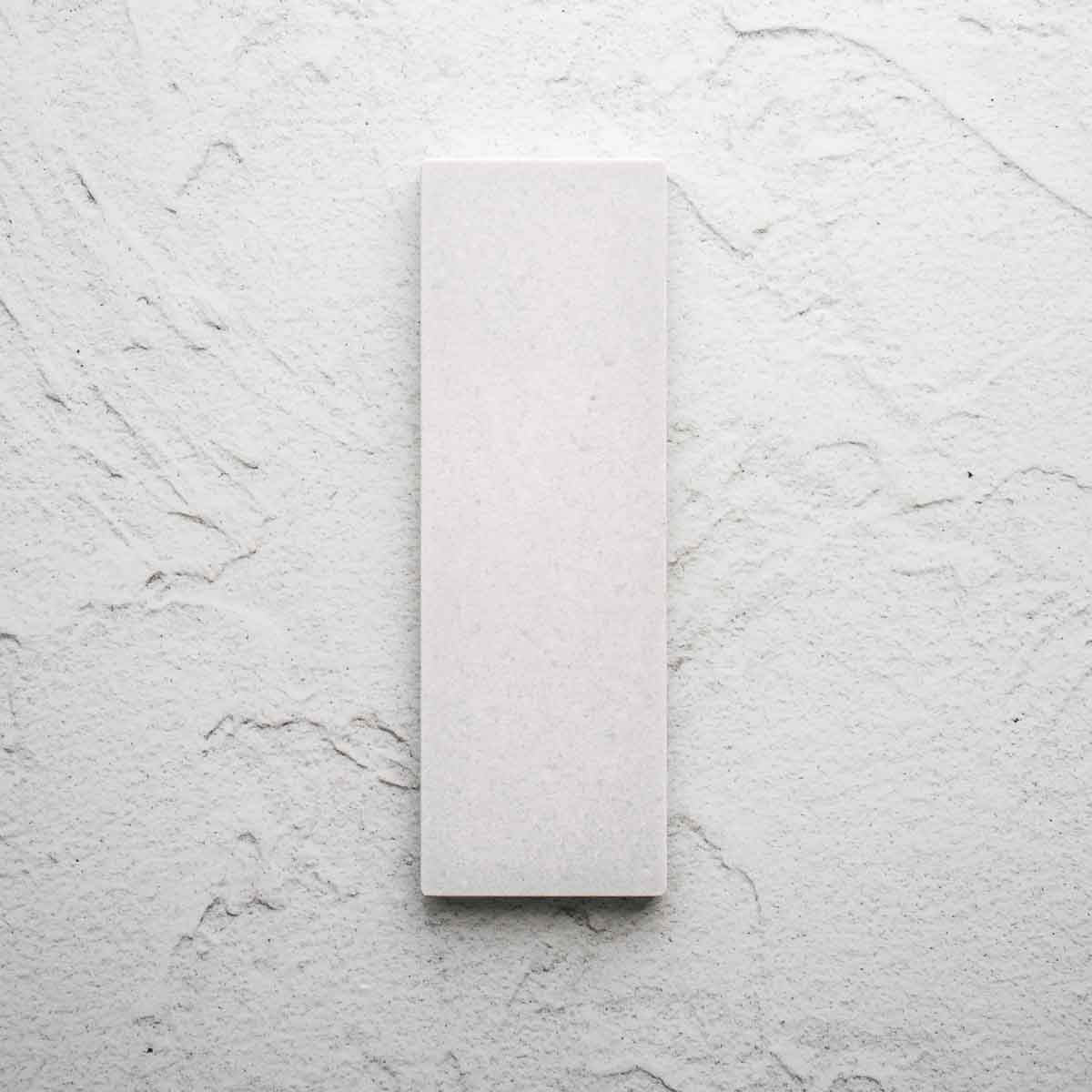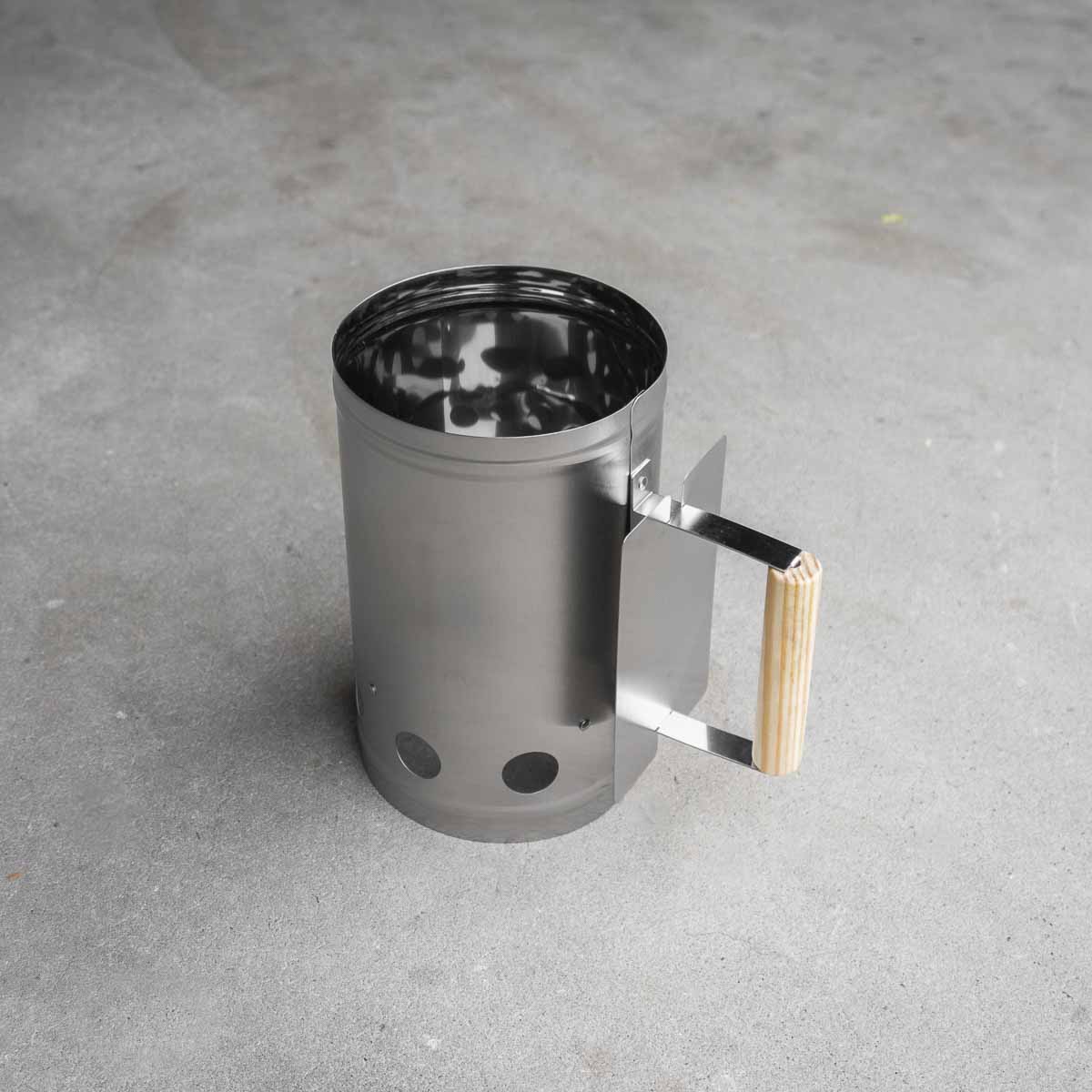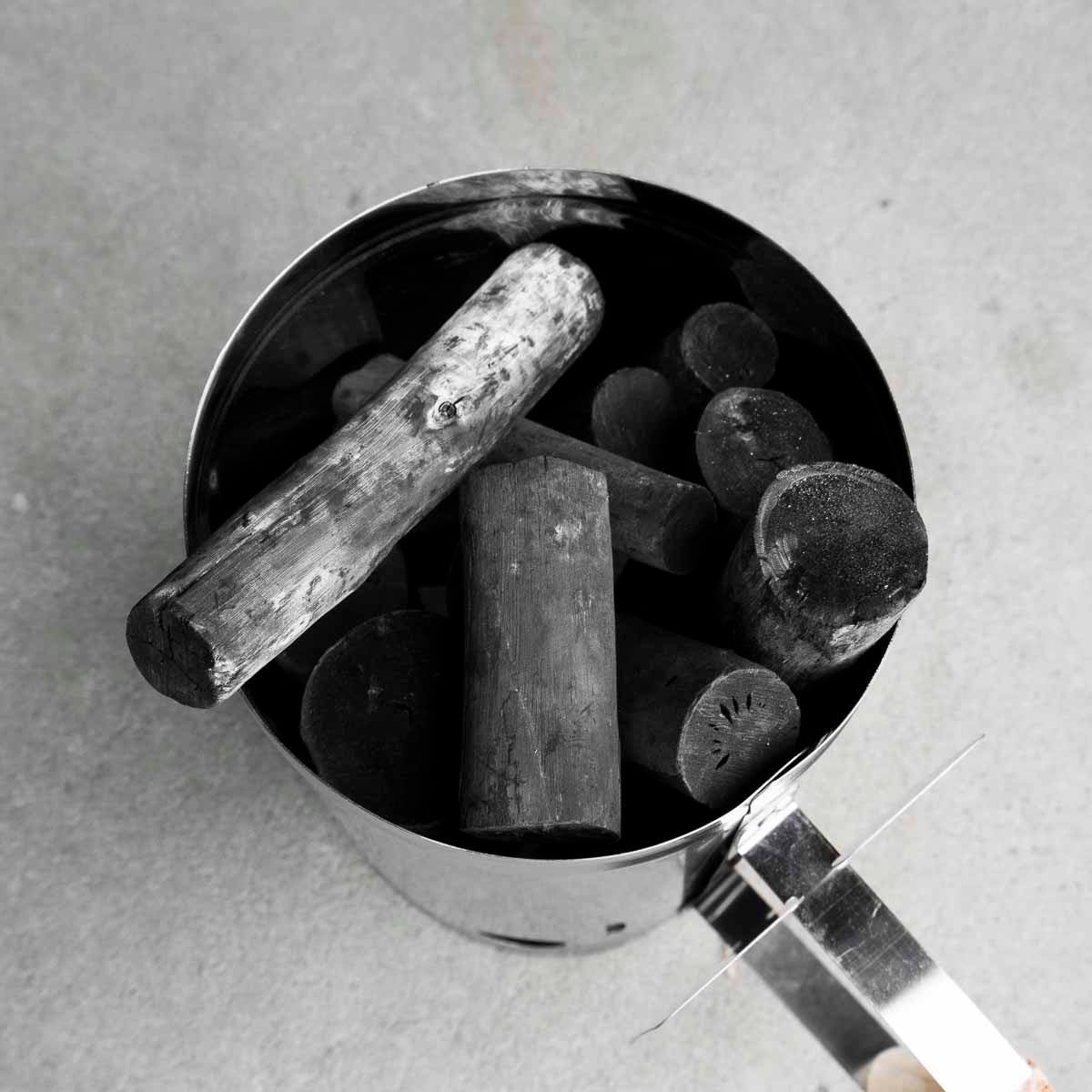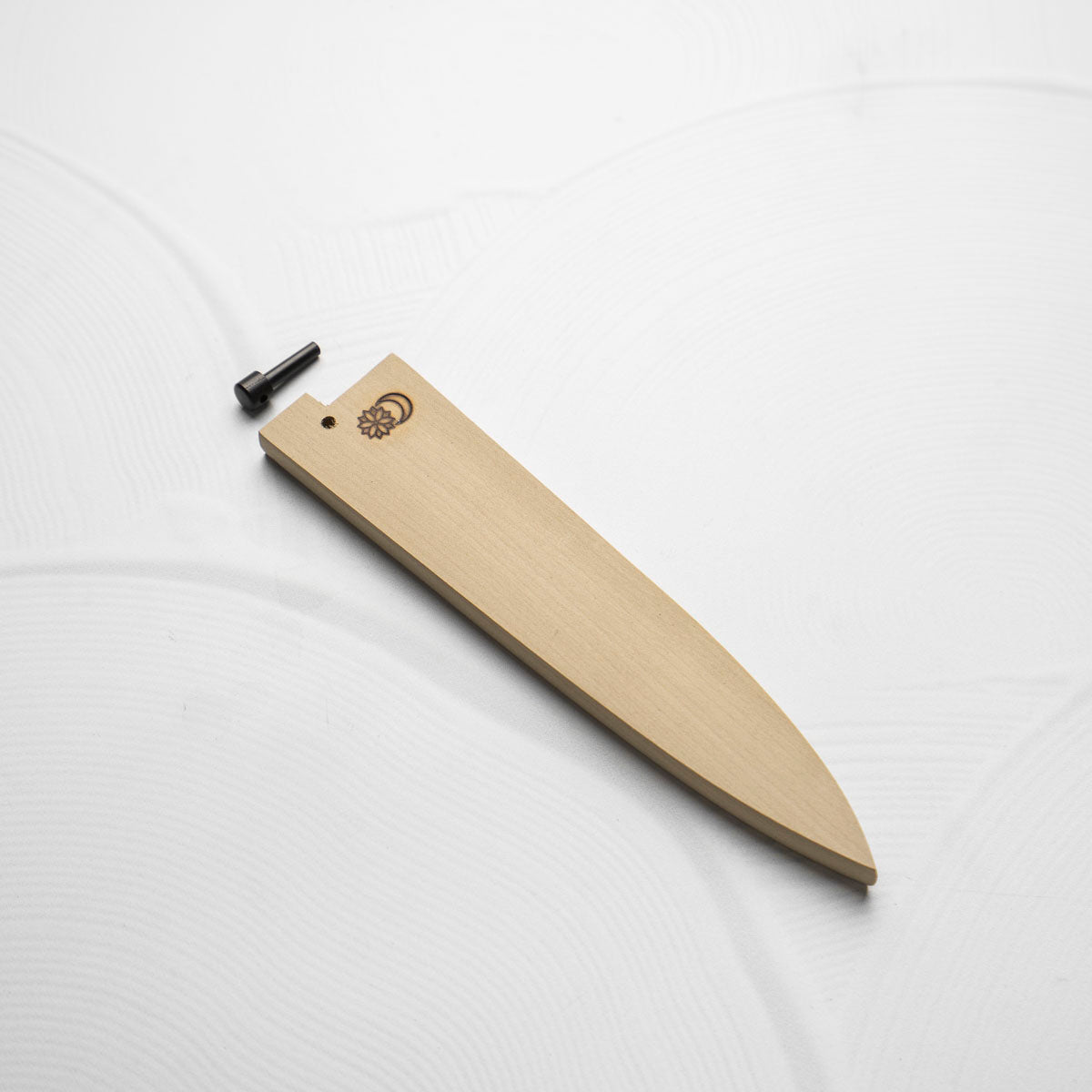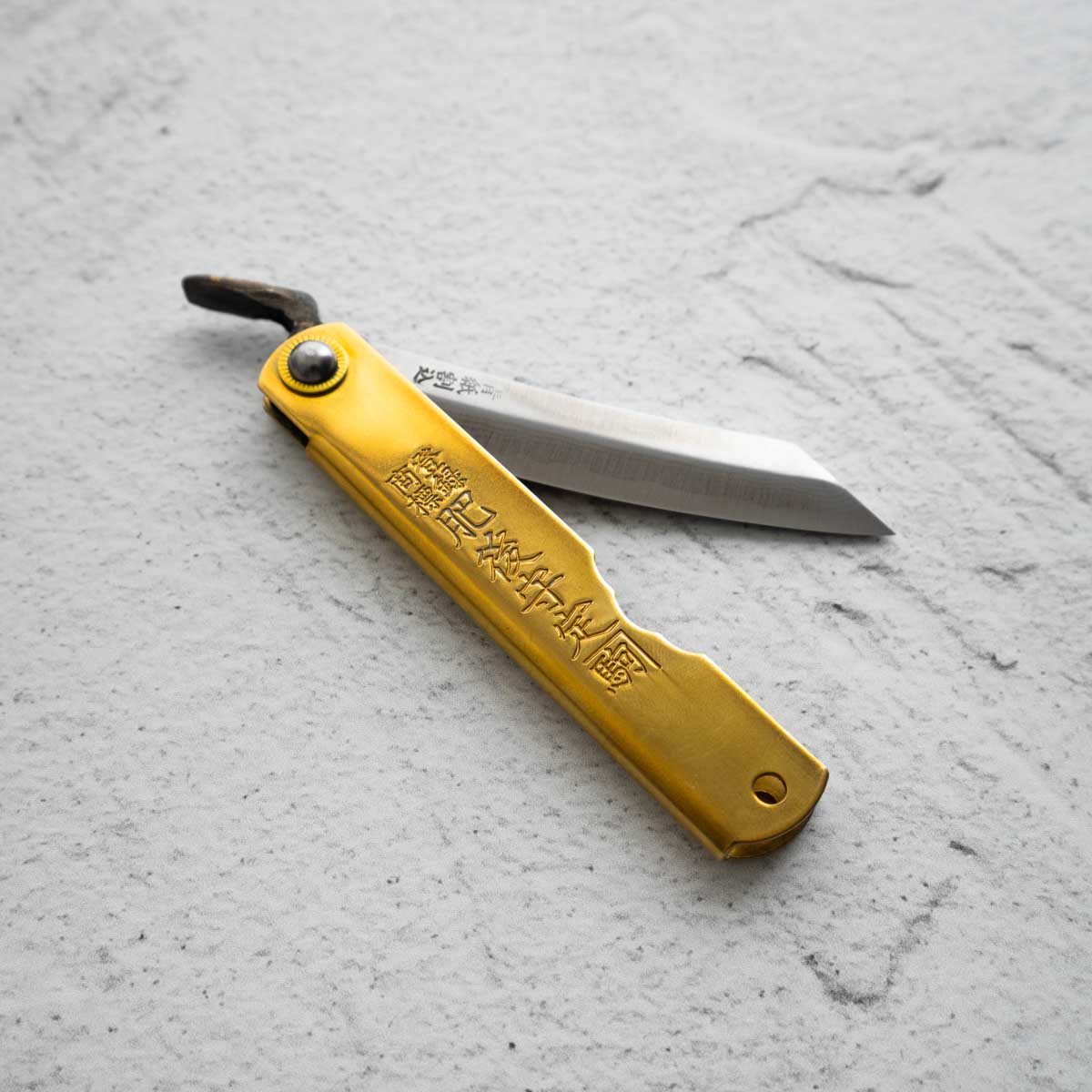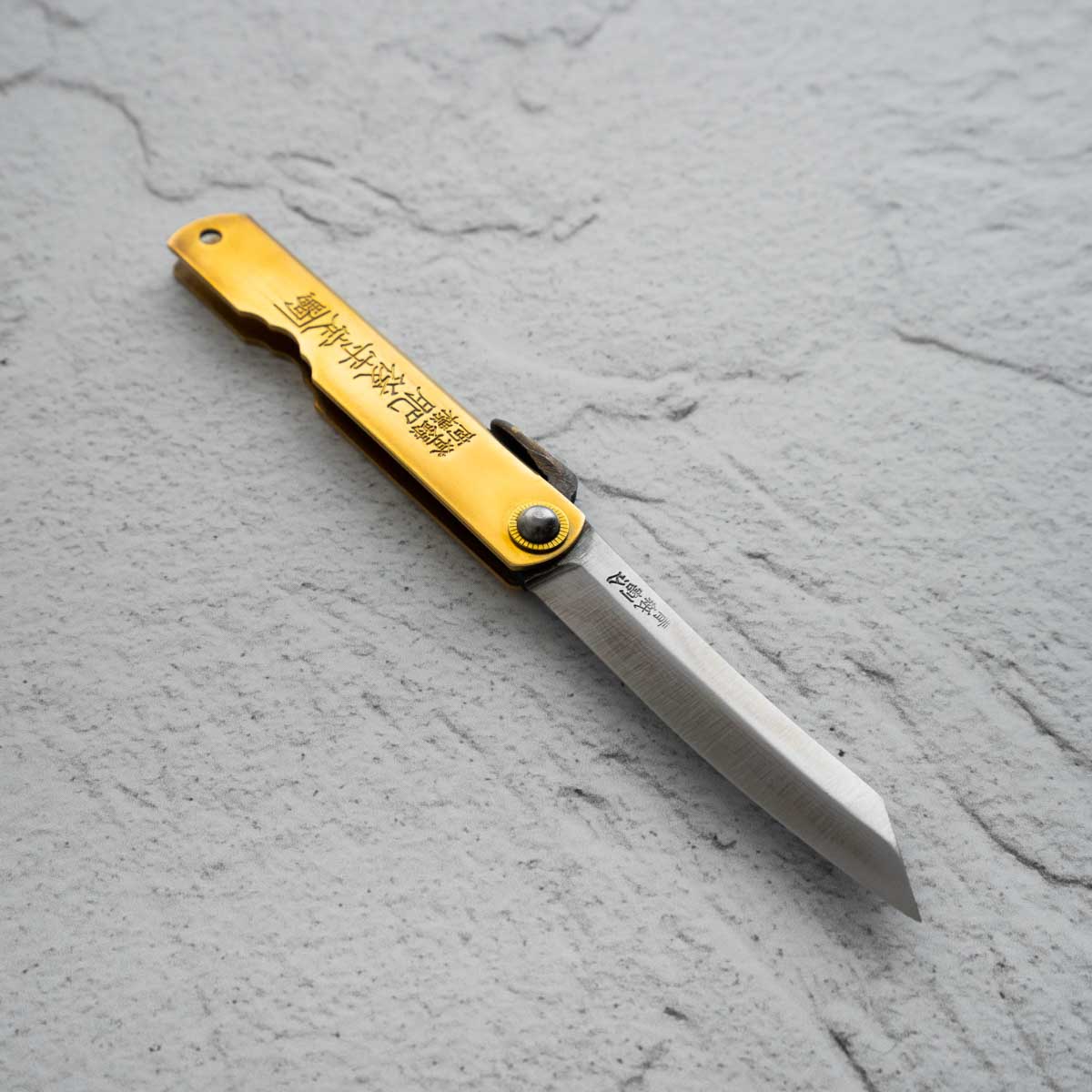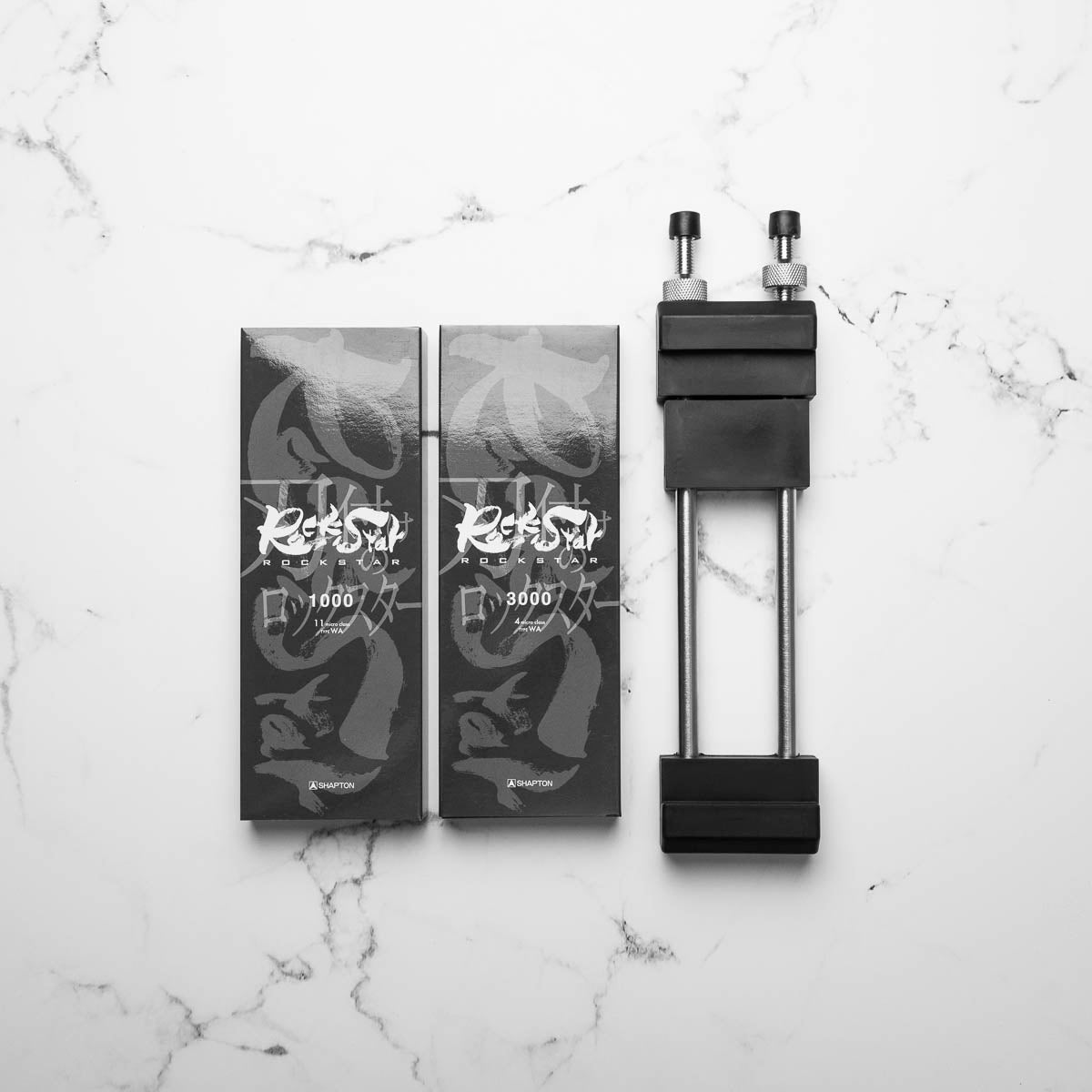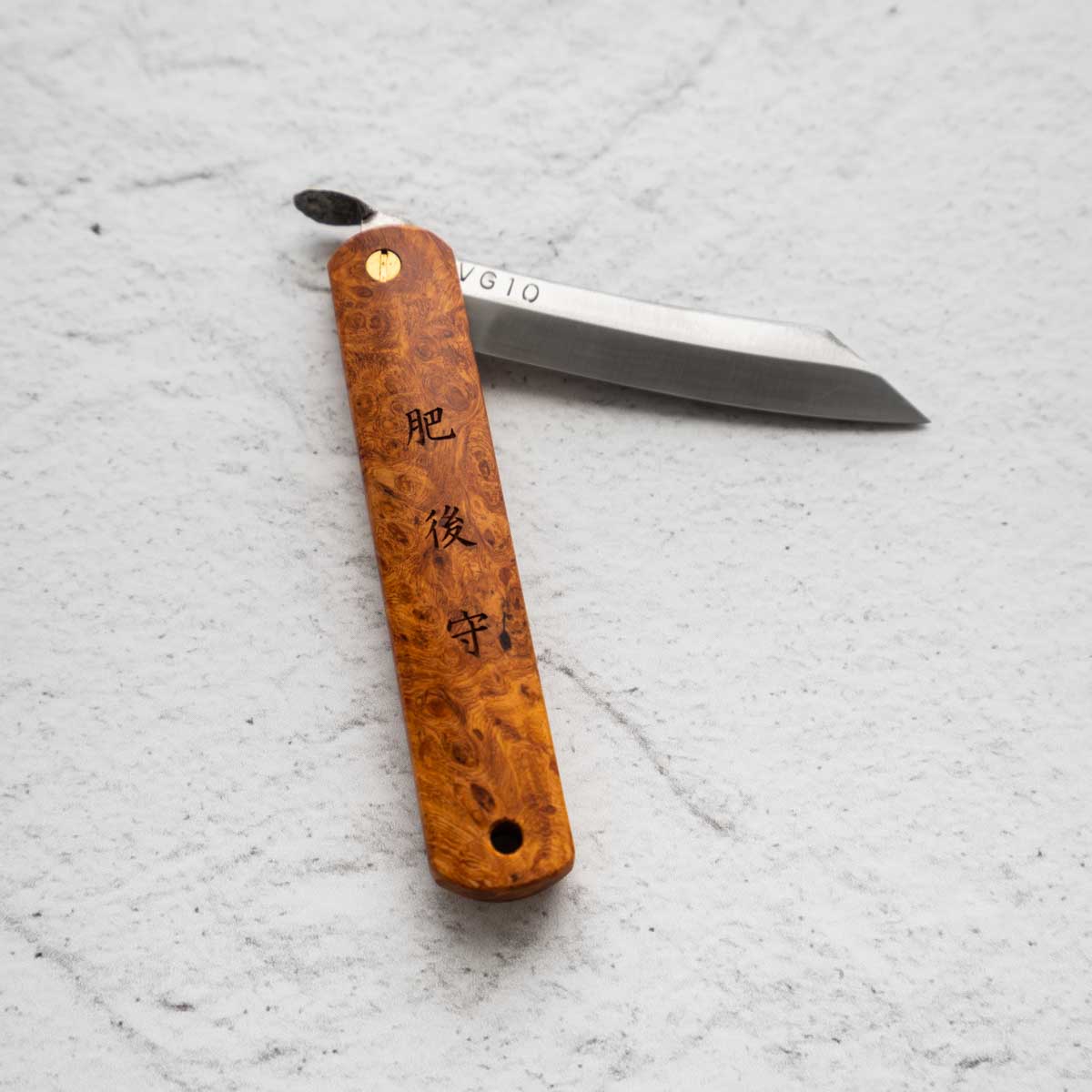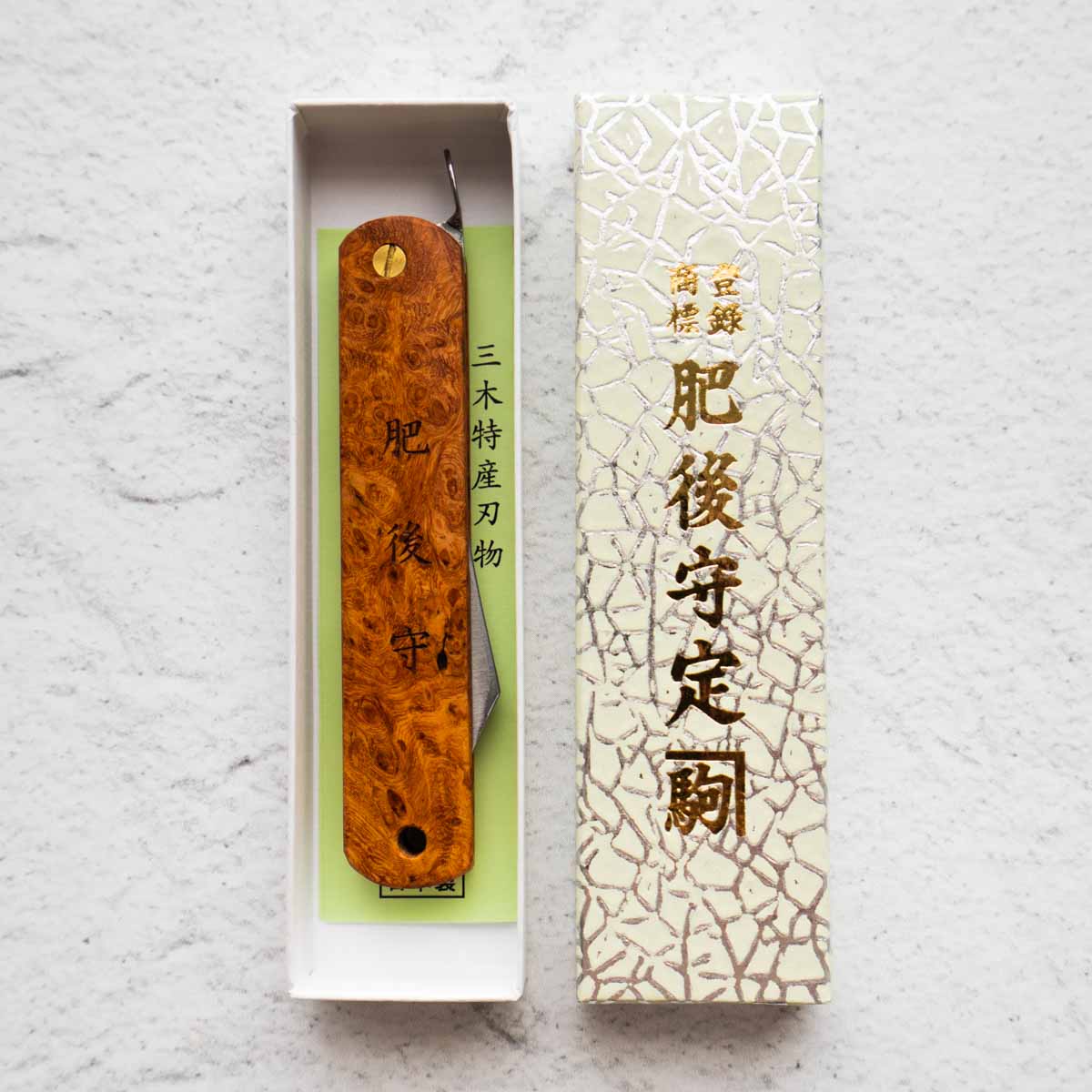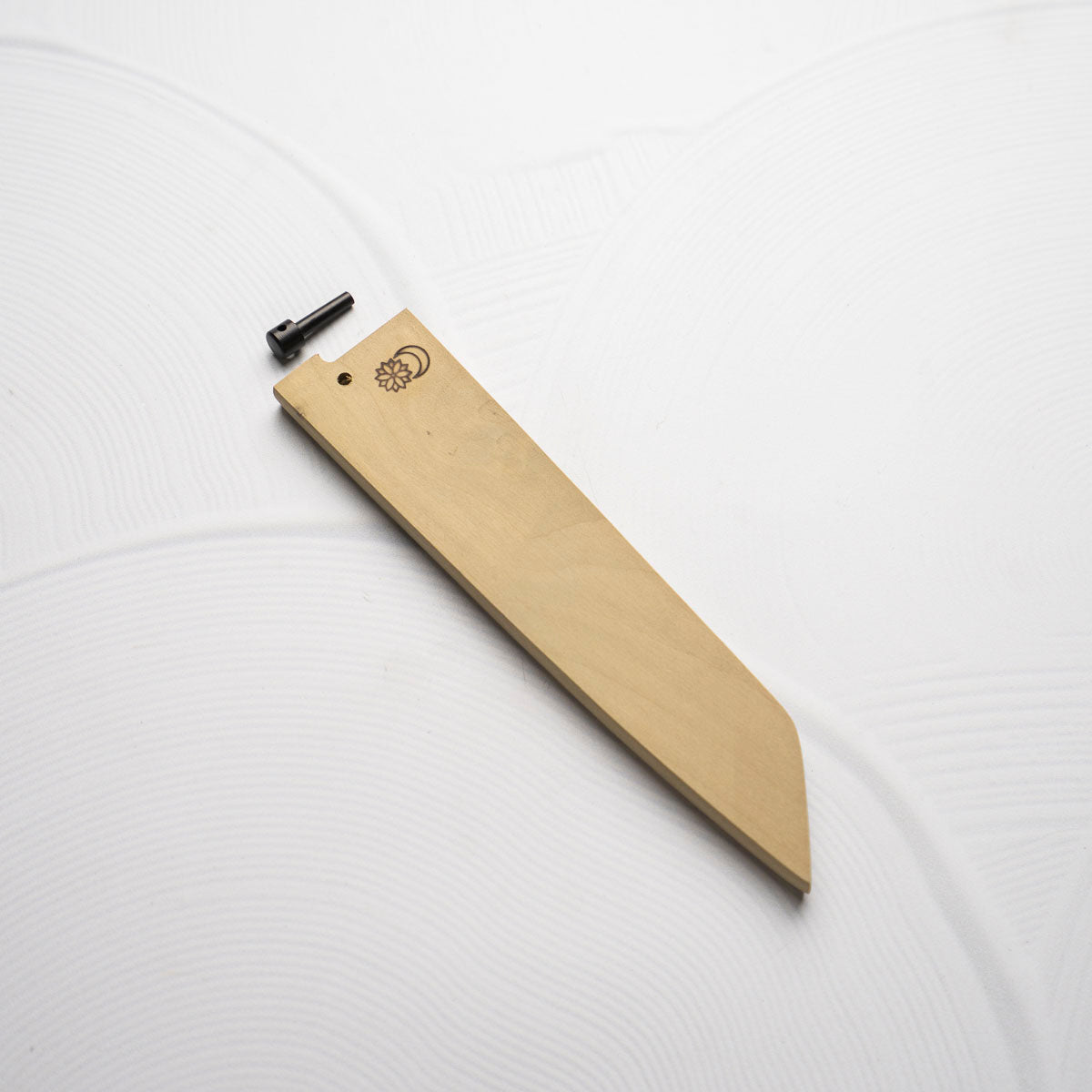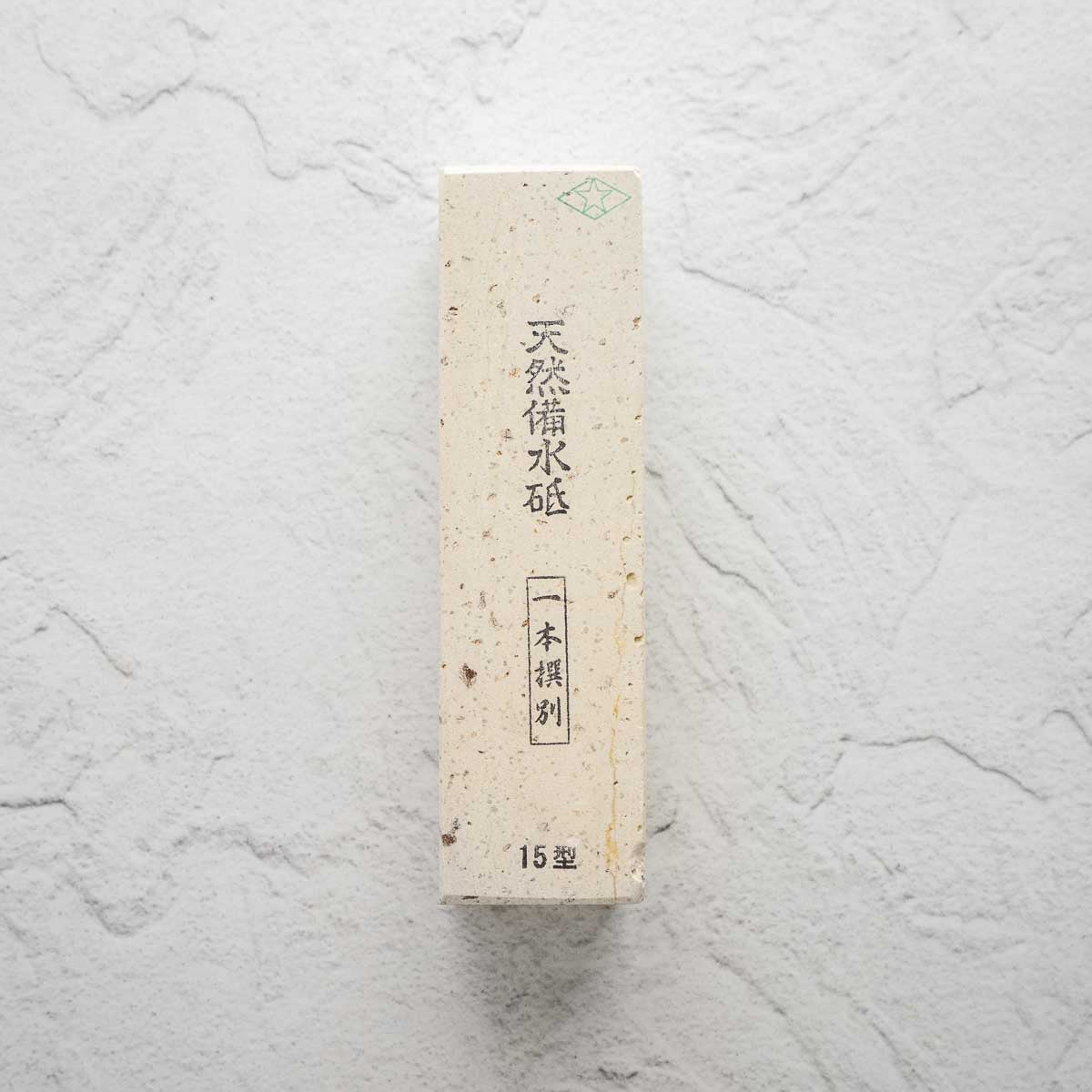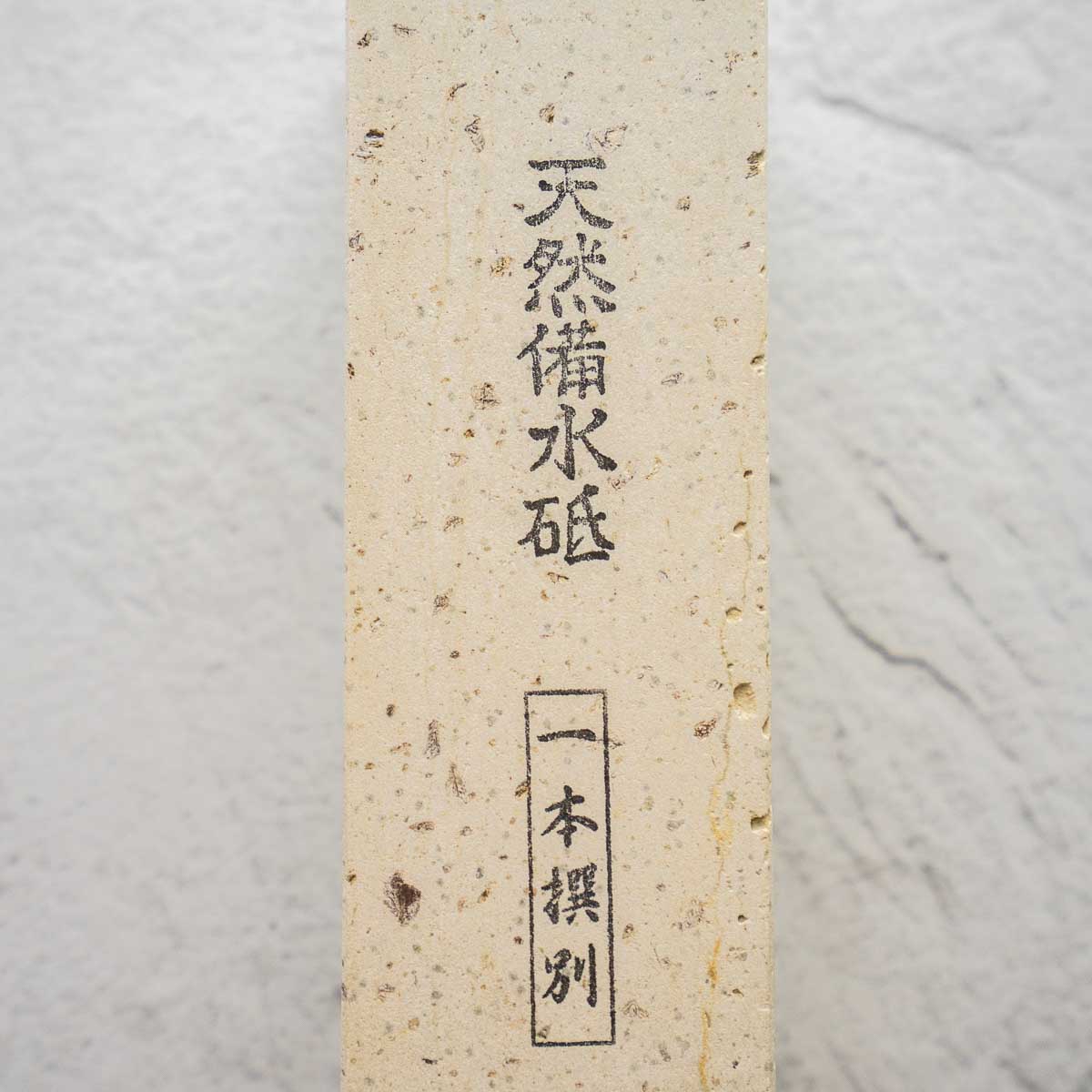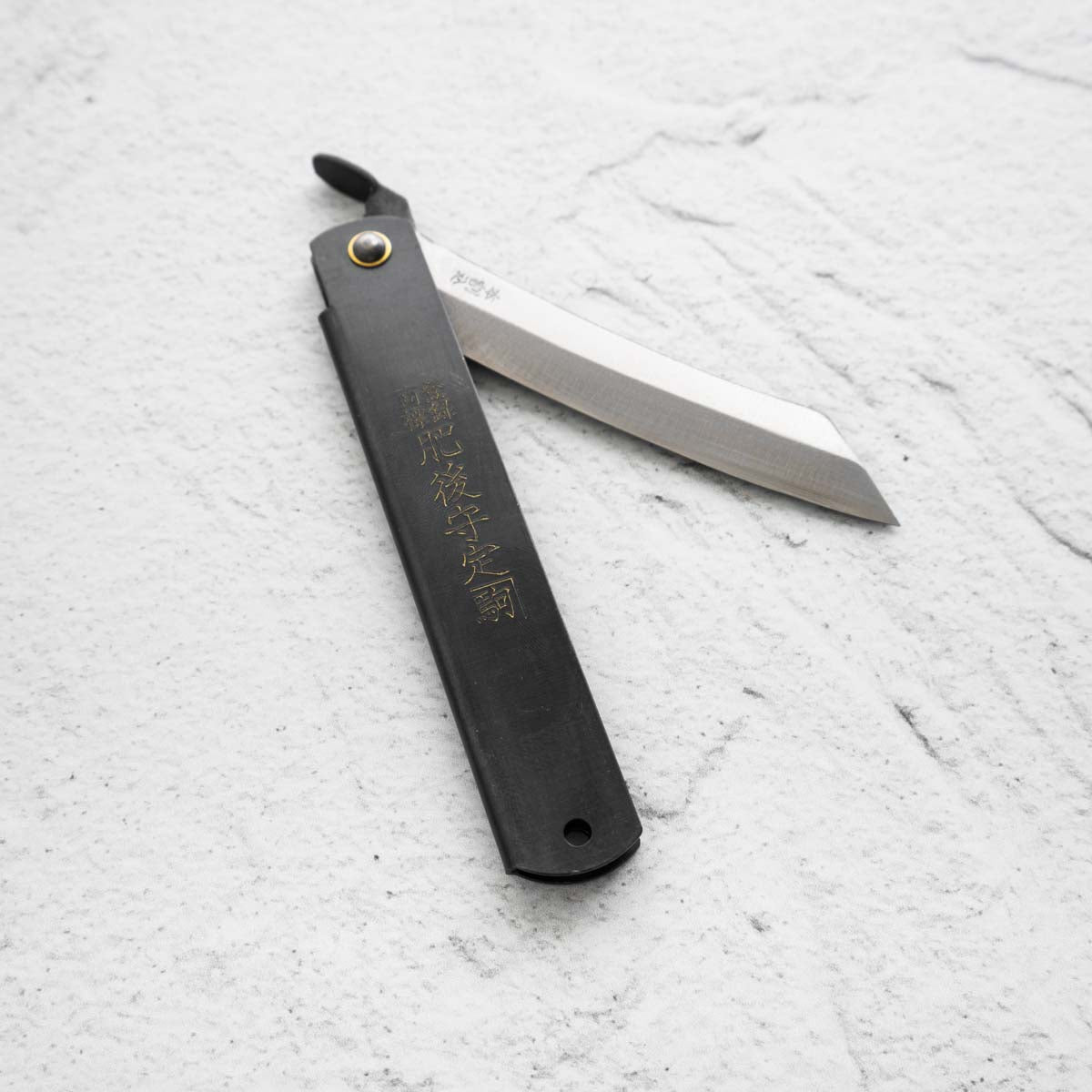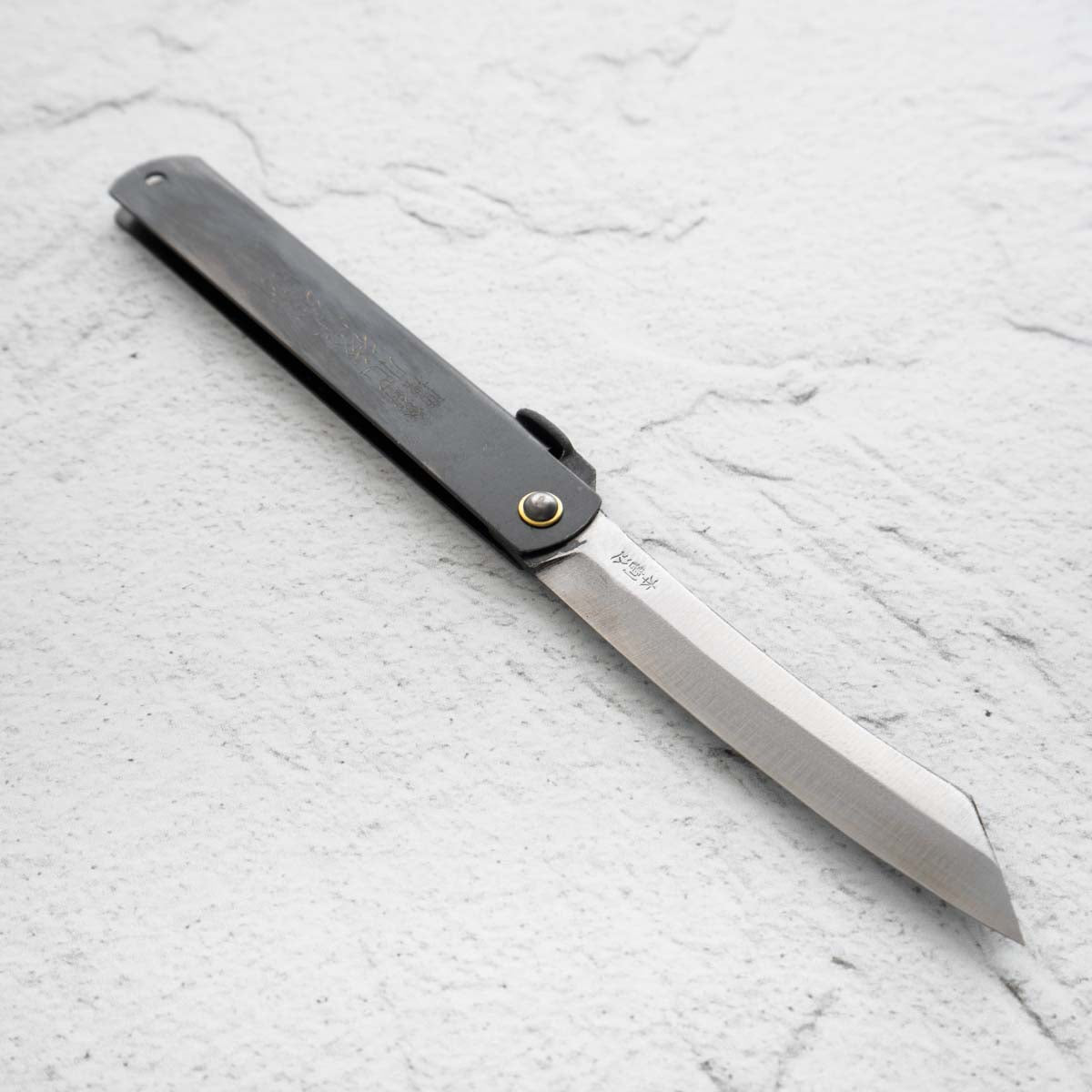Sort by:
279 products
279 products
When you're trying to achieve an ultra-precise edge, the slightest wobble or vibration can result in distortions in the blade. The GS Holder is heavy enough to use as a sharpening base, and its form gives it stability far higher than that of the GS Field Holder.
- Dimensions: 259 x 86 x 56mm
- Weight: approx. 1,960g
Knife Information
A traditional Japanese tool for woodworking and leather crafting. It has a single bevel edge much like Japanese sushi knives, meaning it can be sharpened to have an extremely sharp edge.
Brand: Morihei
Profile: Kiridashi
Steel Type: Blue #1 (Aogami)
Total Length: 201mm
Blade Length: 45mm
Bevel Symmetry: Single Bevel
Hand Orientation: Right Handed
Weight: 35g
Knife Information
1894- Mr. Tasaburo Shigematsu, a hardware wholesaler, introduced a new pocket knife with its blade and sheath folded by installing a small handle “Chikiri (tail)” on the blade, while inspired by the knife he brought back from Kagoshima.
He named it “Higonokami Knife” because many of his customers were in Kumamoto area (formally Higo country), which turned out to dramatically increase his sales. The blades have gradually changed their shapes. Unlike single-edged knives, the double-edged blades (V-shaped cross section) were in those days considered common. The earlier blades had a sharper tip (shape of a bamboo leaf), but now they have square shapes. The sheaths had a vertically folding style and a cross folding style, now the vertical one has to be custom made.
In 1911, at the First Kobe Export Articles Competitive Exhibition, Crown Prince (later Emperor Taisho) liked Higonokami on display very much and bought one, which is said to have helped its fame further spread.
The Higonikami is a fantastic traditional utility knife at a low cost.
Specifications
| Style: | Higonokami |
| Blade Length: | 70mm |
| Weight: | 50g |
| Bevel: | Double Bevel |
| Blade Material: | Aogami (Blue) Steel |
| Handle Material: | Engraved Brass w/hand-polished Black coating |
Accessory Information
The Atoma Diamond Lapping Plates by Tsuboman Japan are widely recognised as the superior solution for flattening your whetstones. Strong, sturdy, and weighing in at just shy of 700g, these will make light work of even the hardest stones.
*Replacement Sheet only with adhesive backing*
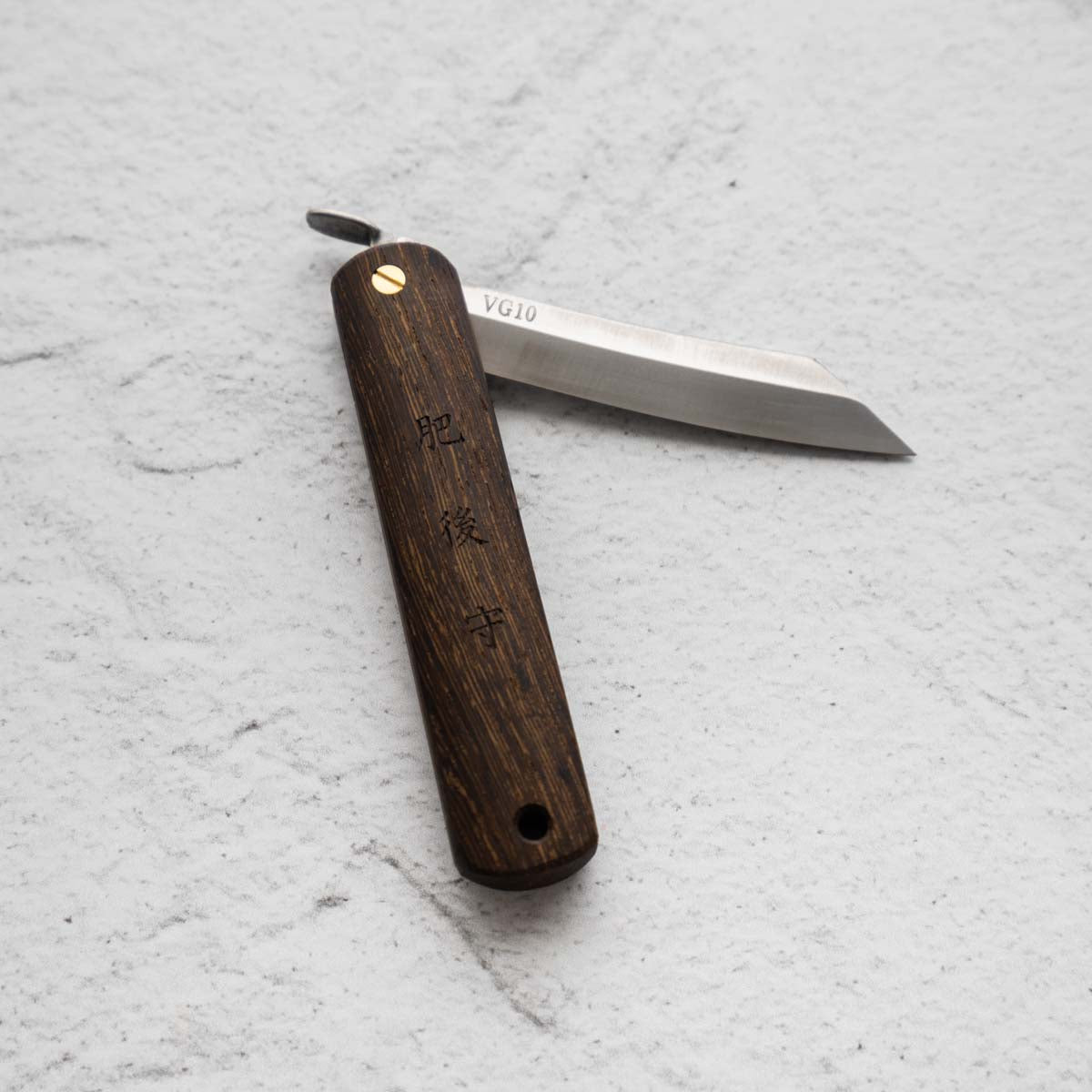
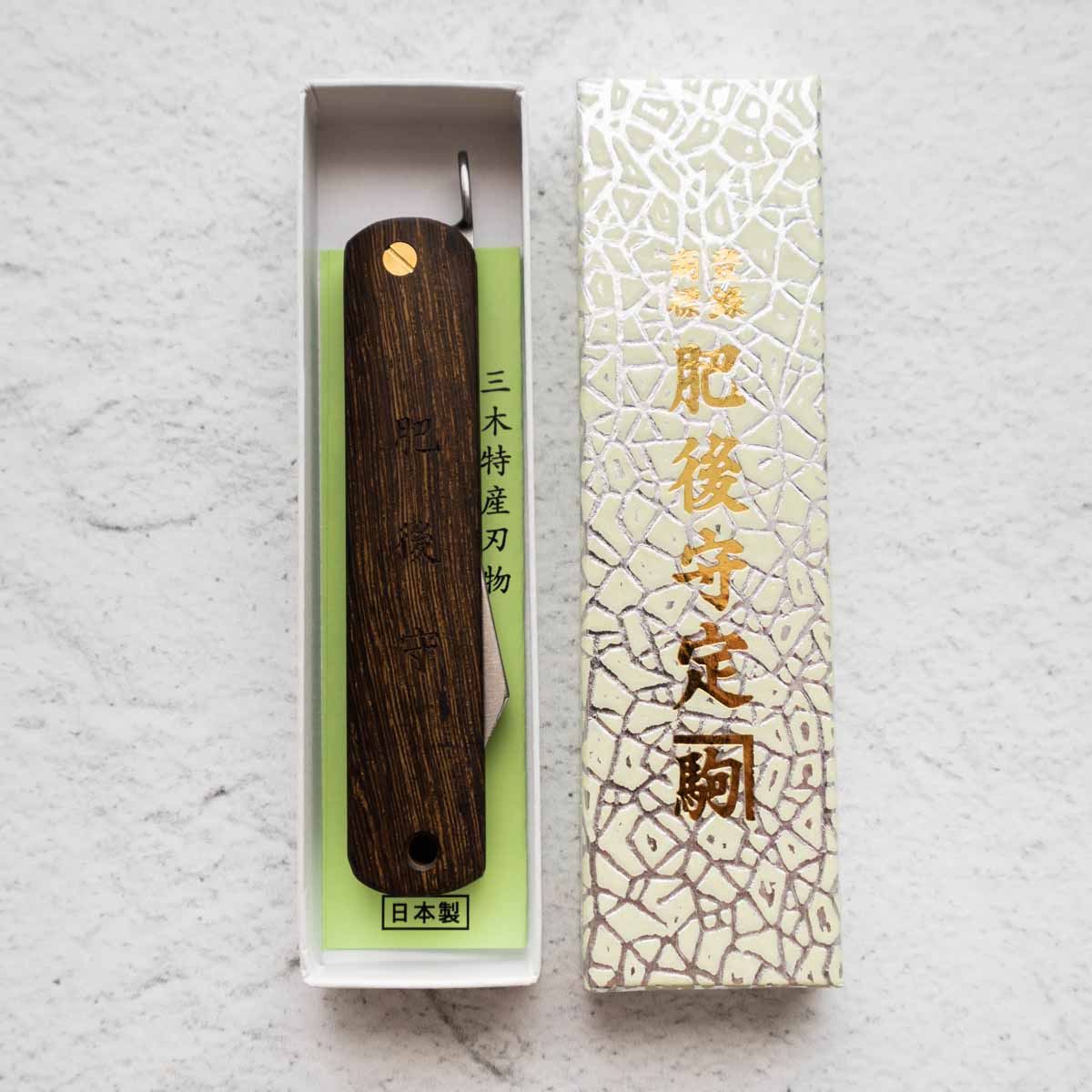
Nagao Kanekoma Higonokami VG10 Custom - Bombay Blackwood - No 49
Nagao Kanekoma Higonokami VG10 Custom - Bombay Blackwood - No 49
Knife Information
1894- Mr. Tasaburo Shigematsu, a hardware wholesaler, introduced a new pocket knife with its blade and sheath folded by installing a small handle “Chikiri (tail)” on the blade, while inspired by the knife he brought back from Kagoshima.
He named it “Higonokami Knife” because many of his customers were in Kumamoto area (formally Higo country), which turned out to dramatically increase his sales. The blades have gradually changed their shapes. Unlike single-edged knives, the double-edged blades (V-shaped cross section) were in those days considered common. The earlier blades had a sharper tip (shape of a bamboo leaf), but now they have square shapes. The sheaths had a vertically folding style and a cross folding style, now the vertical one has to be custom made.
In 1911, at the First Kobe Export Articles Competitive Exhibition, Crown Prince (later Emperor Taisho) liked Higonokami on display very much and bought one, which is said to have helped its fame further spread.
The Higonikami is a fantastic traditional utility knife at a low cost.
Specifications
| Style: | Higonokami |
| Blade Length: | 70mm |
| Weight: | 32g |
| Bevel: | Double Bevel |
| Blade Material: | VG10 Stainless Steel |
| Handle Material: | Custom Engraved Bombay Blackwood |
Accessories Information
The GlassStone series of sharpening stones uses a revolutionary design to provide great usability within a thin package formed from a combination of glass layers. The conventional image is that sharpening stones are large and heavy, but GlassStones are not only thin and light, but also strong, as layers of tempered glass are stuck together. GlassStones therefore have strong resistance to cracking or sudden breakage caused by external shocks such as being dropped.
Shapton stones do not need to be soaked except the very first time after purchase. We do recommend that on first use, you pre-soak the stone in water for five to six minutes to secure even smoother sharpening. Shapton stones do not need a Nagura Stone, and lapping with a Nagura Stone will leave the surface rough and ragged.
Accessories Information
Elevate your culinary travels with the assured protection of the 5 Pocket 1000D PVC Chef Knife Bag. This fundamental bag is meticulously crafted for both accomplished chefs and emerging culinary talents, showcasing a streamlined roll-up design paired with six dedicated cutlery pockets.
Exceptional and Practical Features:
- Convenient Roll-Up Design: Enhance portability and effortless access.
- Durable 1000D PVC: Experience lasting resilience and timeless style.
- Customized Knife and Tool Storage: Five specialized pockets for organized and accessible storage.
- Enhanced Security: Robust exterior and interior strap for optimal tool safety.
- Luxurious Leather Accents: Genuine buffalo leather details for an elevated aesthetic appeal.
- Additional Zippered Utility Pocket: Extra space for essential items.
- Elegant Accents: Black buckles and accents for a refined touch.
- Expansive When Open: Unfurls to a generous 21.5" x 19" (55 cm x 48.25 cm) for easy and convenient access to tools.
- Internal Dimensions: Individual Pocket Width ~ 44mm. Accommodates knives up to 450mm in length (including Handle).
Knife Information
A traditional Japanese tool for woodworking and leather crafting. It has a single bevel edge much like Japanese sushi knives, meaning it can be sharpened to have an extremely sharp edge.
Brand: Morihei
Profile: Kiridashi
Steel Type: Blue #1 (Aogami)
Total Length: 197mm
Blade Length: 54mm
Bevel Symmetry: Single Bevel
Hand Orientation: Right Handed
Weight: 71g
Accessories Information
The GlassStone series of sharpening stones uses a revolutionary design to provide great usability within a thin package formed from a combination of glass layers. The conventional image is that sharpening stones are large and heavy, but GlassStones are not only thin and light, but also strong, as layers of tempered glass are stuck together. GlassStones therefore have strong resistance to cracking or sudden breakage caused by external shocks such as being dropped.
Shapton stones do not need to be soaked except the very first time after purchase. We do recommend that on first use, you pre-soak the stone in water for five to six minutes to secure even smoother sharpening. Shapton stones do not need a Nagura Stone, and lapping with a Nagura Stone will leave the surface rough and ragged.
- Overall size: 210 x 70 x 10mm
- Abrasive layer: 5mm
- Micron: 2.45
- Mesh: 6000
- 360g
Knife Information
1894- Mr. Tasaburo Shigematsu, a hardware wholesaler, introduced a new pocket knife with its blade and sheath folded by installing a small handle “Chikiri (tail)” on the blade, while inspired by the knife he brought back from Kagoshima.
He named it “Higonokami Knife” because many of his customers were in Kumamoto area (formally Higo country), which turned out to dramatically increase his sales. The blades have gradually changed their shapes. Unlike single-edged knives, the double-edged blades (V-shaped cross section) were in those days considered common. The earlier blades had a sharper tip (shape of a bamboo leaf), but now they have square shapes. The sheaths had a vertically folding style and a cross folding style, now the vertical one has to be custom made.
In 1911, at the First Kobe Export Articles Competitive Exhibition, Crown Prince (later Emperor Taisho) liked Higonokami on display very much and bought one, which is said to have helped its fame further spread.
The Higonikami is a fantastic traditional utility knife at a low cost.
Specifications
| Style: | Higonokami |
| Blade Length: | 75mm |
| Weight: | 62grams |
| Bevel: | Double Bevel |
| Blade Material: | Aogami (Blue) Steel Damascus - Hand Forged |
| Handle Material: | Brass |
Accessories Information
The Rockstar Series from Shapton improve on the GlassHR Series by removing the glass backing, and adding extra stone thickness for a longer lifespan. They are a hard stone that offers lighter feedback levels than other stones, but cut very fast, require no soaking, and are very slow to dish.
- Overall size: 210 x 70 x 10mm
- Micron: 11
-
Mesh: 1000
Accessories Information
The Rockstar Series from Shapton improve on the GlassHR Series by removing the glass backing, and adding extra stone thickness for a longer lifespan. They are a hard stone that offers lighter feedback levels than other stones, but cut very fast, require no soaking, and are very slow to dish.
This 1000 & 3000 Combination Set is perfect for daily maintenance of stainless steel and carbon, for users that wish to retain some toothiness.
Accessories Information
The Rockstar Series from Shapton improve on the GlassHR Series by removing the glass backing, and adding extra stone thickness for a longer lifespan. They are a hard stone that offers lighter feedback levels than other stones, but cut very fast, require no soaking, and are very slow to dish.
This 1000 & 3000 Combination Set is perfect for daily maintenance of stainless steel and carbon, for users that wish to retain some toothiness.
Accessories Information
The Rockstar Series from Shapton improve on the GlassHR Series by removing the glass backing, and adding extra stone thickness for a longer lifespan. They are a hard stone that offers lighter feedback levels than other stones, but cut very fast, require no soaking, and are very slow to dish.
This full progression includes the 320, 500, 1000, 3000, 6000, 8000, and 16000 grit stones, plus a holder.
Knife Information
1894- Mr. Tasaburo Shigematsu, a hardware wholesaler, introduced a new pocket knife with its blade and sheath folded by installing a small handle “Chikiri (tail)” on the blade, while inspired by the knife he brought back from Kagoshima.
He named it “Higonokami Knife” because many of his customers were in Kumamoto area (formally Higo country), which turned out to dramatically increase his sales. The blades have gradually changed their shapes. Unlike single-edged knives, the double-edged blades (V-shaped cross section) were in those days considered common. The earlier blades had a sharper tip (shape of a bamboo leaf), but now they have square shapes. The sheaths had a vertically folding style and a cross folding style, now the vertical one has to be custom made.
In 1911, at the First Kobe Export Articles Competitive Exhibition, Crown Prince (later Emperor Taisho) liked Higonokami on display very much and bought one, which is said to have helped its fame further spread.
The Higonikami is a fantastic traditional utility knife at a low cost.
Specifications
| Style: | Higonokami |
| Blade Length: | 70mm |
| Weight: | 32g |
| Bevel: | Double Bevel |
| Blade Material: | VG10 Stainless Steel |
| Handle Material: | Custom Engraved Quince Burl |
Put ground coffee in the strainer and slowly pour in water to brew. Leave in your refrigerator for about eight hours to brew.
Colour: Black
Width: 8.7 cm
Depth: 8.4 cm
Height: 30 cm
Diameter: 7.1 cm
Capacity: 650ml
Weight: 0.5kg
Material: Heatproof glass pot. Polyester resin filter. Polypropylene strainer. Silicone bottle spout and stopper
Full instructions: https://global.hario.com/product/FIC-70.pdf
About the Natsuya
The Binsui is a natural whetstone used at the start of a natural stone progression. They are of slighter higher hardness and are fast cutting.
All natural stone sales are final, we try to provide the best possible representation of the stone via our images.
*Available to Australian customers only - International customers please contact us to purchase*
Accessory Information
The Atoma Diamond Lapping Plates by Tsuboman Japan are widely recognised as the superior solution for flattening your whetstones. Strong, sturdy, and weighing in at just shy of 700g, these will make light work of even the hardest stones.
– Low 140 Grit for fast removal of stone surface
– Integrated handle makes flattening incredibly fast & easy
– Replaceable abrasive sheet
- 7.5cm x 21cm plate size
Knife Information
1894- Mr. Tasaburo Shigematsu, a hardware wholesaler, introduced a new pocket knife with its blade and sheath folded by installing a small handle “Chikiri (tail)” on the blade, while inspired by the knife he brought back from Kagoshima.
He named it “Higonokami Knife” because many of his customers were in Kumamoto area (formally Higo country), which turned out to dramatically increase his sales. The blades have gradually changed their shapes. Unlike single-edged knives, the double-edged blades (V-shaped cross section) were in those days considered common. The earlier blades had a sharper tip (shape of a bamboo leaf), but now they have square shapes. The sheaths had a vertically folding style and a cross folding style, now the vertical one has to be custom made.
In 1911, at the First Kobe Export Articles Competitive Exhibition, Crown Prince (later Emperor Taisho) liked Higonokami on display very much and bought one, which is said to have helped its fame further spread.
The Higonikami is a fantastic traditional utility knife at a low cost.
Specifications
| Style: | Higonokami |
| Blade Length: | 92mm |
| Weight: | 70g |
| Bevel: | Double Bevel |
| Blade Material: | Laminated SK Carbon Steel |
| Handle Material: | Black Nickel |
Chef's Edge
We pride ourselves on offering an unparalleled selection of Japanese knives. From the versatile Gyuto and the precise Santoku to specialized knives like the Nakiri and Yanagiba, each knife is handpicked for its quality and performance.

